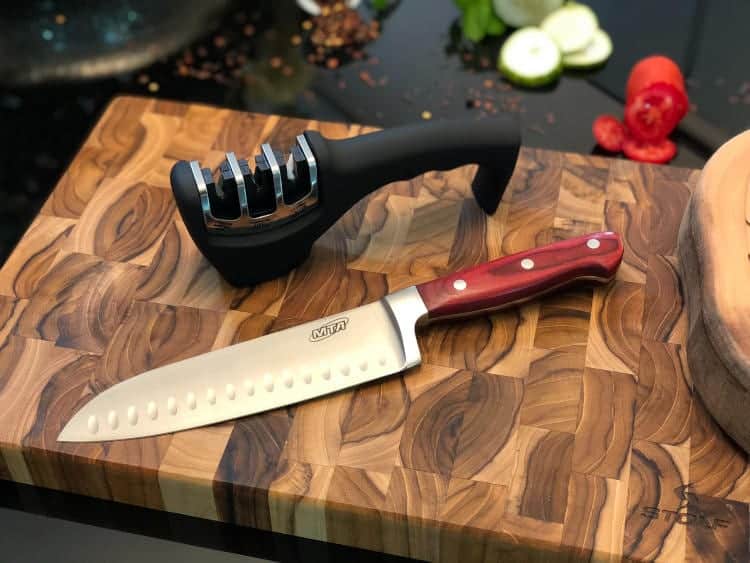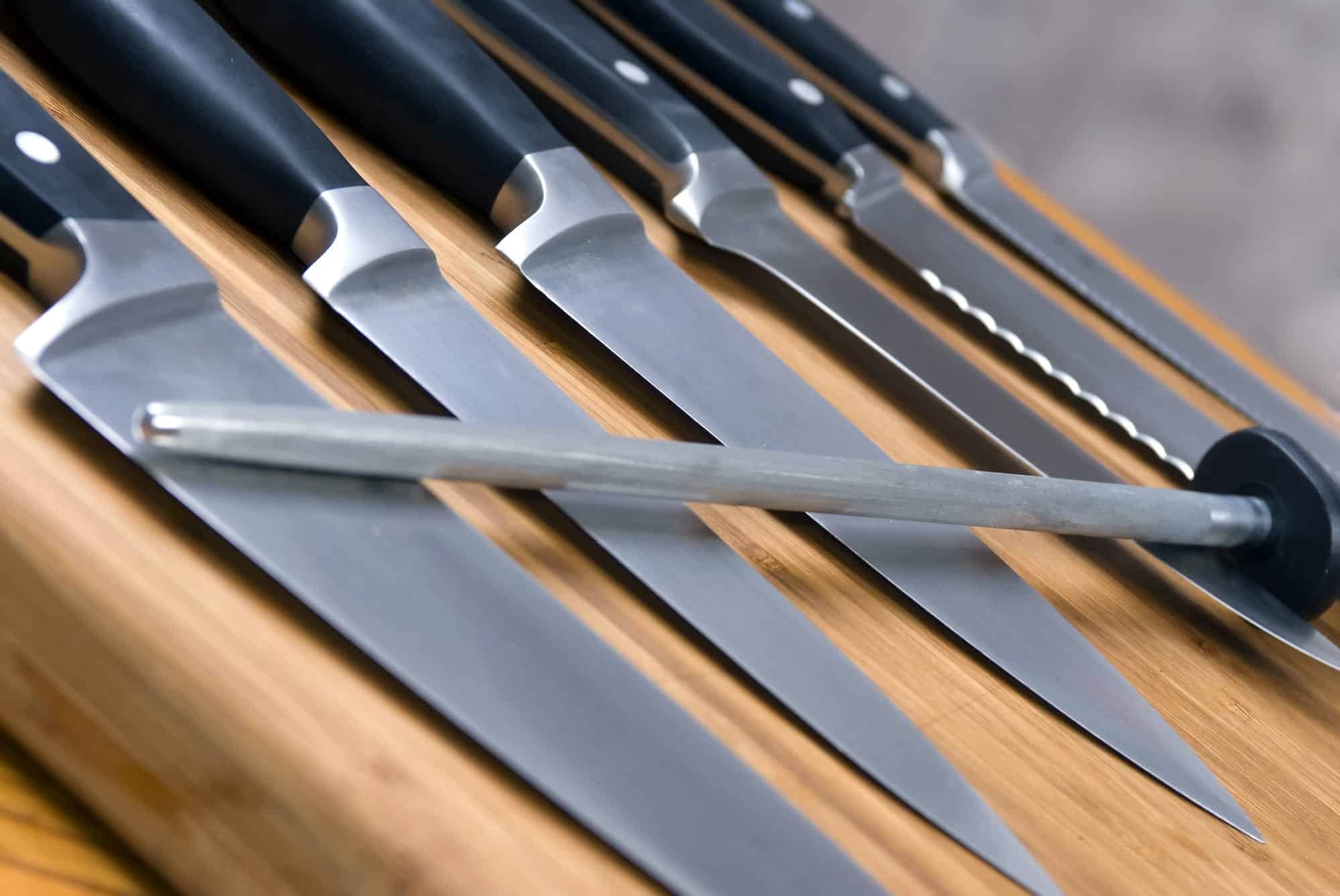We are cooking at home more than ever, in fact, 82% of meals are currently made at home, so it is high time we learn to treat our kitchen tools properly!
Knowing how often to sharpen knives in the kitchen is a key skillset that everyone should know. We are going to take an in-depth look at caring for your knives in the best way possible.
Let’s get started!
How Often to Sharpen Knives
For standard kitchen use, your chef knives should be sharpened only a few times a year. With that being said, you should hone your knife weekly, don’t worry, we will touch more on that later!
The type of knife you are using plays a big factor in the frequency of sharpening as does the quality of the blade and the food it is used with.
In the world of knife sharpening and honing, the process is very complex with many varying factors that contribute to how and when you should sharpen. Let’s explore some key points regarding sharpening your knives!
Anatomy of the Blade
The standard kitchen chef’s knife is comprised of 7 points:
- Heel
- Blade
- Edge
- Tang
- Bolster
- Rivets
- Handle
When sharpening your knives the goal is to achieve a like-new edge on your blade. A dull or uneven edge on the blade can make the handle wobble when cutting. In turn, this can make it harder to cut and increases the chances of injury due to its lack of stability.
Understanding the anatomy of your knife is important regarding sharpening. Improper handling of your knife while sharpening could lead to poor sharpening or a nasty cut! Never handle your knife by its blade, instead always handle it by its handle without letting your hand move beyond the bolster or heel.
Sharpening and Honing
When it comes to maintaining the edge of your blade there are two standard techniques to master…sharpening and honing. When you sharpen a knife you are grinding down the metal on the edge of the blade. This process results in the removal of damaged pieces of metal along the edge and restores the original V-shape of the edge of the blade.
When you hone your blade you will use what is known as honing steel or sharpening steel. This tool will align the tines of the blade creating the perfect V-shape angle before using your knife to cut.
Honing the knife does not make it sharp, and honing a dull blade could damage the edge. However, when honing a sharpened blade it could make the edge feel sharper because the process alines the edge of the blade to create the V-shape.
How to Hone Kitchen Knives
If you are using carbon steel knives you should hone your knife before each use. Honing is simply used for alignment, so generally speaking, you should only hone your knife after every few uses.
When you hone your knife it is important not to overdo it! Do not swipe your blade back and forth dozens of times over the sharpening steel as this will wear down the edge of the blade and could cause it to break. Instead, use the following steps to perfectly hone your blade:
- Place your sharpening steel vertically on a sturdy countertop
- Place the heel of the blade at the top of the sharpening steel with the tip of the blade facing away from your body
- With light pressure and the blade at a 15-degree angle, pull the blade down in a sweeping motion against the steel
- Repeat the process 4 to 5 times on each side of the blade
This process will help to perfectly align the edge of your knife. Always use a firm grip but light pressure to avoid injury or damage to the blade.
Sharpening Kitchen Knives
There are a variety of techniques that can be used to sharpen your kitchen knives. Keeping a sharp blade will actually make your knife safer as dull blades are less balanced and can be harder to use.
These are the most popular options for sharpening your knife:
- Oilstone
- Waterstone
- whetstone
- Electric sharpener
- Handheld sharpener
- Diamond sharpener
Each of these options has its pros and its cons. When choosing the best option for your blade it depends on the quality of the blade, the material it is made out of, and your personal preferences. Let’s take an in-depth look at some of the options.
The Stones
Stone sharpeners, like sandpaper, have varying levels of grit. When you sharpen with stones you should have a finer grit and a heavier grit.
A Whetstone sharpener, despite its name, doesn’t need to be wet. It is a relatively inexpensive option for sharpening that is adaptable to almost any knife. It does take time to master the whetstone, so if you are new to sharpening or your blade is very dull another option might be better suited.
The Oilstone and Waterstone both need to be saturated before use with either oil or water. The Oilstone tends to be a little messier than the Waterstone, but it is fairly easy to use.
Diamond stones are the most durable option out of all the stone-style sharpeners. They can be used wet or dry, but they are more expensive than the other options.
Sharpening with Stones
When you are sharpening with stones you might need to add liquid such as water or oil before beginning depending on the style of stone sharpener. Always hold your blade at a 10 to 15-degree angle and use 4-6 pounds of pressure as you pull the blade across the stone.
Always use your primary hand when sharpening for stability and safety. Be sure to start the process with the heavier grit sharpening stone and then after a few passes switch to the finer grit. When you are finished wash your blade and wipe it clean.
Handheld and Electric
Electric sharpeners are a favorite for home chefs because they are durable and easy to use. The chamber for knife sharpening is spring-loaded to limit the movement of the knife to help create the perfect edge. With that being said, electric sharpeners cannot be used on all types of knives and they can be quite expensive.
Handheld non-electric sharpeners are inexpensive and can sharpen even the dullest blade in little to no time at all. Their small design makes them easy to store in limited space. The downfall is that even the best manual sharpener cannot remove severe damage from a blade

When to Sharpen a Kitchen Knife
There are a few ways to tell when it is time to sharpen your kitchen knife. One of the easiest and most common ways in the paper test.
Hold a single piece of paper or newspaper out in front of your body. Then carefully place the knife at the top of the paper and try to slice through.
If your blade slices through with ease then it does not need to be sharpened. If it doesn’t slice through the first time then you should try to hone your blade and attempt to slice again. If the blade still does not cut through it is time to sharpen your blade.
With proper honing, storage, and care your blade should only need to be sharpened a few times a year. Oversharpening can happen if you are not using the right tools or methods to sharpen.
Sharpening Cheap Steel
When using inexpensive steel in the kitchen, sharpening can become an issue. Cheaper steel loses its edge more quickly than a high-quality blade. Additionally, inexpensive blades can clog up electric or handheld sharpeners as the metal shavings break off more easily.
In the end, when it comes to buying knives for your kitchen spending a little more upfront on quality steel could save your wallet and your sharpeners in the long run!
Keeping Your Knives in the Best Shape
Now that you know how often to sharpen knives in your kitchen you are well on your way to making sure they are kept in the best possible condition. Your knives should always be washed after you sharpen them as the metal shavings could stick to the blade of the knife.
After washing always be sure to thoroughly dry your clean blade and store it in a secure and dry location. The more acute your angle is after sharpening the sharper your blade will be. Try using a few different sharpeners to see which one best fits your needs.
Do you want to learn more about all things knives? Good! We are here to teach! Contact us today to learn more about your knives.

